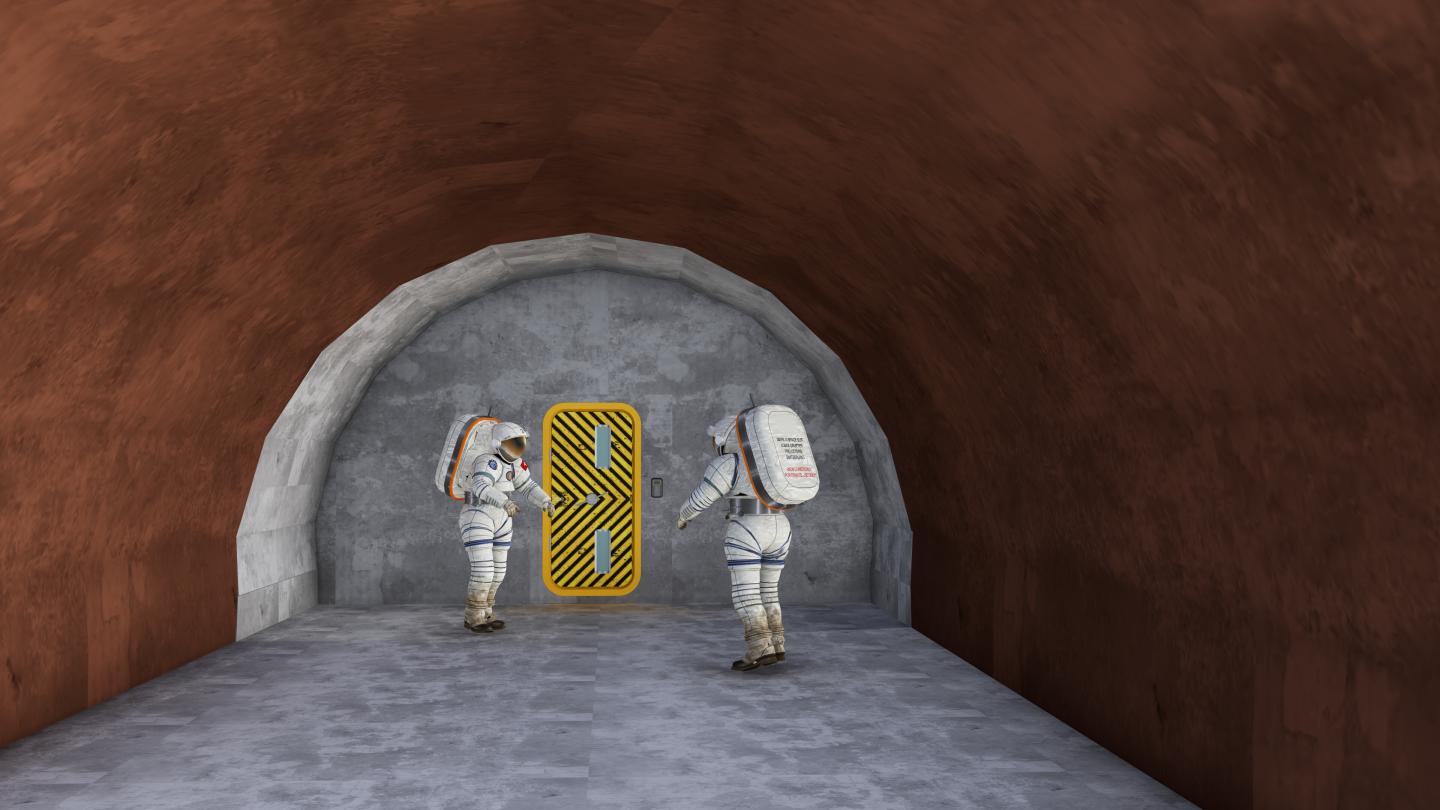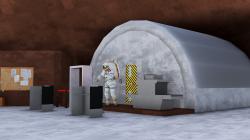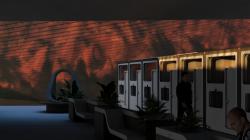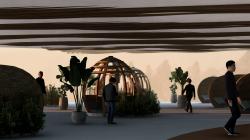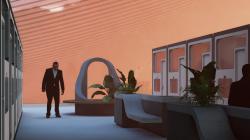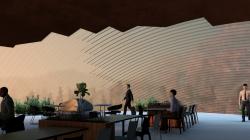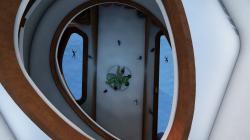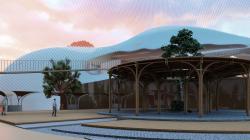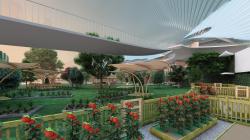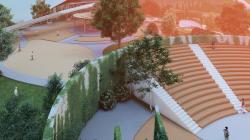Interior Design Intentions for the Space Hotel on Mars
Designing the interior of the Space Hotel on Mars poses a unique challenge, given the harsh conditions of the Martian environment and the need to create a comfortable, functional, and psychologically supportive habitat for both astronauts and space tourists. The goal is to create an immersive experience that balances technological advancements, sustainable practices, and human-centered design to ensure the guests’ physical and mental well-being during their stay.
Key Objectives
The interior design has several critical objectives:
Human Comfort and Mental Well-being: Creating a psychologically supportive environment that helps guests adjust to the challenges of living in an enclosed space on an alien planet.
Sustainability and Resource Efficiency: Utilizing local resources and sustainable technologies to minimize dependence on Earth-based supplies.
Modularity and Adaptability: Designing spaces that cater to various functions and guest needs, promoting flexibility in an evolving space tourism industry.
Aesthetic and Experiential Design: Making the space visually stimulating and engaging, fostering a sense of wonder and adventure while still providing a sense of safety and familiarity.
Materials and Technology
Given the extreme environmental conditions on Mars, the materials chosen for the interior design must be lightweight, durable, and capable of withstanding temperature fluctuations, low atmospheric pressure, and radiation exposure.
Martian Regolith: The primary building material is Martian regolith, a loose material found on the surface of Mars. This is used in combination with binding agents to 3D-print both exterior and interior walls. It offers structural integrity while providing a connection to the Martian environment. Regolith serves as a natural radiation shield when packed to a depth of 50 cm or more.
Composite Materials: Lightweight composites are used for furniture, wall panels, and ceilings. These materials are resistant to wear, provide insulation, and can be manufactured onsite. Composites also enhance the structural stability of the interior while reducing energy consumption due to their insulating properties.
Acoustic and Thermal Insulation: Special materials are used to manage temperature and sound. Insulated panels within the walls help maintain a stable internal temperature of around 20-22°C, while acoustic materials ensure a quiet, peaceful environment, especially in communal and sleeping areas.
Geothermal and Solar Power Systems: The hotel is powered primarily by a geothermal energy plant located beneath the structure. This is supplemented by solar panels on the hotel exterior, providing reliable energy for heating, lighting, water purification, and life support systems.
Lighting and Circadian Rhythm Support
Given the limited sunlight on Mars and the psychological impact of the reddish Martian sky, creating Earth-like lighting conditions is vital to maintaining guests' circadian rhythms.
Dynamic LED Lighting Systems: The lighting systems are designed to mimic Earth’s day-night cycle to maintain guests' circadian rhythms, which are critical for both physical and mental health. The hotel uses adjustable LED lighting that shifts in intensity and color temperature over a 24.6-hour day (close to Earth’s 24-hour cycle). Bright, cool-toned lights simulate daylight, while softer, warmer lights mimic dusk and night.
Task and Ambient Lighting: Each sleeping pod, private quarters, and common area is equipped with task and ambient lighting that guests can control individually, giving them the ability to tailor their environment to their preferences. For instance, ambient lighting in the pods can be dimmed for relaxation, while brighter task lighting is available for reading or other activities.
Skylights and Mars Windows: In key areas like lounges and dining rooms, the design incorporates skylights and windows that allow for views of the Martian landscape. While the windows are equipped with radiation shielding, the natural light and views provide a psychological connection to the outside world, easing feelings of confinement.
Sleeping Pods and Private Spaces
One of the critical components of the hotel’s interior design is the sleeping pods, which are designed to be personal sanctuaries for the guests, offering comfort, privacy, and advanced technology.
Customized Pods: Each pod is fully customizable, equipped with smart technology that allows guests to adjust the lighting, temperature, and sound environment. The beds are adaptable for the lower gravity of Mars (0.38g) and provide adjustable support to ensure comfort. The pods also feature high-performance acoustic insulation to minimize external noise.
Personal Space and Storage: Although compact, the pods provide ample storage for personal belongings, and modular designs allow for the reconfiguration of the space to suit individual needs. The walls of the pods are made of composite materials designed to absorb sound and provide insulation, ensuring privacy and comfort.
Smart Technology: The pods are equipped with touch-screen panels and voice-activated controls, allowing guests to easily control all aspects of their environment, including lighting, temperature, and communication with the rest of the hotel. A built-in entertainment system offers virtual reality (VR) experiences, which can simulate environments from Earth or provide interactive explorations of Mars.
Communal Spaces
The communal spaces are designed to foster social interaction while maintaining a connection to the natural world through biophilic design elements. These spaces provide a range of activities that help break the monotony of life on Mars and ensure a positive experience for guests.
Common Lounges: The hotel has several lounges equipped with comfortable seating, panoramic windows, and lighting systems that simulate natural conditions. These lounges serve as informal gathering spaces for guests to relax and socialize. The use of natural materials such as wood-like composites, soft fabrics, and Earth-inspired color schemes creates a welcoming and familiar environment.
Dining Areas: The dining spaces are designed to accommodate flexible seating arrangements and cater to various group sizes. Vertical hydroponic gardens grow fresh produce for the hotel’s dining needs, and these living walls also add a touch of nature to the space, offering a sense of calm and connection to Earth.
Fitness and Wellness Centers: Physical fitness is vital in the lower-gravity environment of Mars. The hotel features a fully equipped gym designed for Martian gravity, with specialized equipment to maintain muscle mass and bone density. Additionally, wellness centers offer spa-like treatments, including hydrotherapy pools, meditation rooms, and sensory relaxation chambers.
Biophilic Design and Nature Integration
In an environment as barren and alien as Mars, the integration of natural elements is essential to promoting mental well-being and reducing the psychological strain of living in isolation. Biophilic design principles have been integrated into the interior of the hotel to recreate a connection to nature.
Hydroponic Gardens: Various common areas and dining spaces feature hydroponic gardens that not only supply the hotel with fresh produce but also serve as therapeutic environments for guests. These gardens are designed to offer a sensory experience, with natural scents, colors, and textures. The hydroponic systems are self-contained and highly efficient, minimizing water use while providing a year-round harvest.
Water Features: Despite the scarcity of water on Mars, the hotel incorporates several water features, such as fountains and small reflecting pools, as part of its biophilic design. These water features enhance the tranquility of the communal spaces and serve as a reminder of the hotel’s self-sufficiency, made possible by advanced water recycling and purification systems.
Oasis Room: A designated Oasis Room acts as a serene escape for guests, featuring lush greenery, low ambient lighting, and the soft sound of flowing water. This room provides a calming space for meditation and relaxation, serving as a refuge from the stresses of long-term space travel.
Entertainment and Leisure
To keep guests entertained during their stay, the hotel offers a variety of recreational activities that take advantage of the latest technology and the Martian environment.
Virtual Reality (VR) Rooms: Guests can experience Earth-like environments or explore virtual recreations of Martian landscapes, providing a break from the confined hotel interior. The VR rooms are immersive, using advanced technology to simulate gravity changes, weather conditions, and other environmental factors, offering guests a virtual escape.
Multipurpose Event Spaces: The hotel features several multipurpose spaces designed for lectures, workshops, movie screenings, and social events. These spaces are modular, with movable walls and adjustable seating to accommodate different activities. The design incorporates large projection screens and advanced audio systems, enabling a variety of entertainment options.
Sustainability and Self-Sufficiency
One of the key design principles of the hotel is sustainability, ensuring that the interior functions efficiently while minimizing waste and reliance on Earth-based resources.
Water Recycling: The hotel operates with a closed-loop water recycling system, collecting and purifying water from sinks, showers, and pools. This recycled water is then used for daily operations and irrigation of the hydroponic gardens. The system ensures that water waste is minimized, crucial for long-term sustainability on Mars.
Energy Efficiency: The geothermal power plant, located beneath the hotel, supplies the majority of the hotel’s energy needs. Solar panels provide supplementary power, ensuring that the hotel is energy self-sufficient. All interior systems, from lighting to climate control, are designed to minimize energy consumption while maximizing guest comfort.
Waste Management: The hotel employs advanced waste management techniques, with nearly all waste either recycled or repurposed. Organic waste from the kitchen is composted and used as fertilizer for the hydroponic gardens, while non-organic waste is processed for future use.
Conclusion
The interior design of the Space Hotel on Mars is a complex and multifaceted endeavor, driven by the need to balance human comfort, technological innovation, and sustainability. By incorporating advanced materials, smart technology, and biophilic design elements, the hotel provides a safe, comfortable, and enriching environment for guests. With its attention to psychological well-being, physical comfort, and experiential design, the Space Hotel stands as a symbol of the future of space tourism and human habitation beyond Earth.
2024
The Space Hotel on Mars incorporates advanced technology and innovative materials to withstand the extreme Martian environment. The hotel structure is primarily 3D-printed using Martian regolith, which is combined with specialized binding agents to create a durable, radiation-resistant exterior. The walls are 50 cm thick, providing insulation and shielding from radiation. The hotel’s foundation is designed with a corkscrew anchoring system, securing it against potential seismic activity and Martian winds.
Power is supplied by a geothermal energy system, with backup solar panels for redundancy. Water is extracted from beneath the surface, filtered, and repurposed for drinking, sanitation, and recreational use. The life support system, including MOXIE, generates oxygen and maintains optimal air pressure and temperature. Lighting systems are programmed to simulate Earth-like day-night cycles, supporting guests’ psychological well-being. Communication systems operate on a delay due to the distance between Mars and Earth, utilizing relay satellites to maintain a stable connection. These technical solutions ensure a safe, sustainable, and comfortable environment for all inhabitants.
SWAIN C SHINE
DIBINI BULHAR
